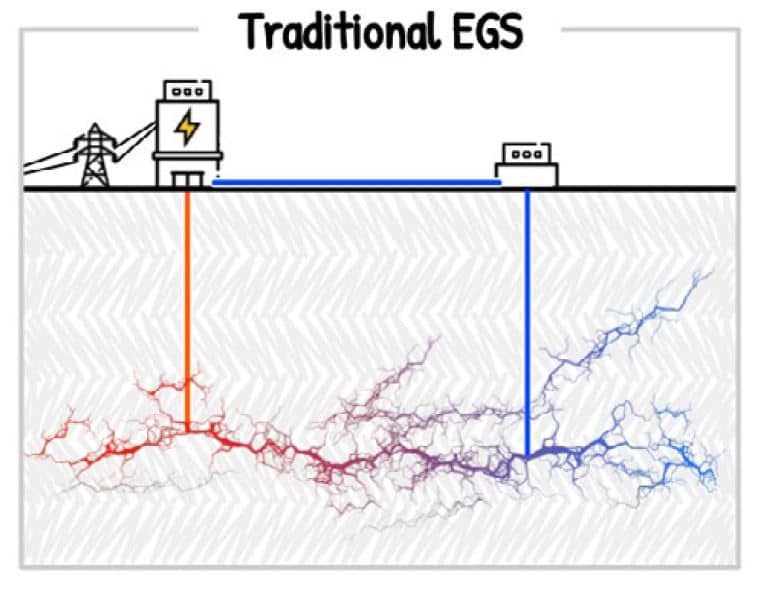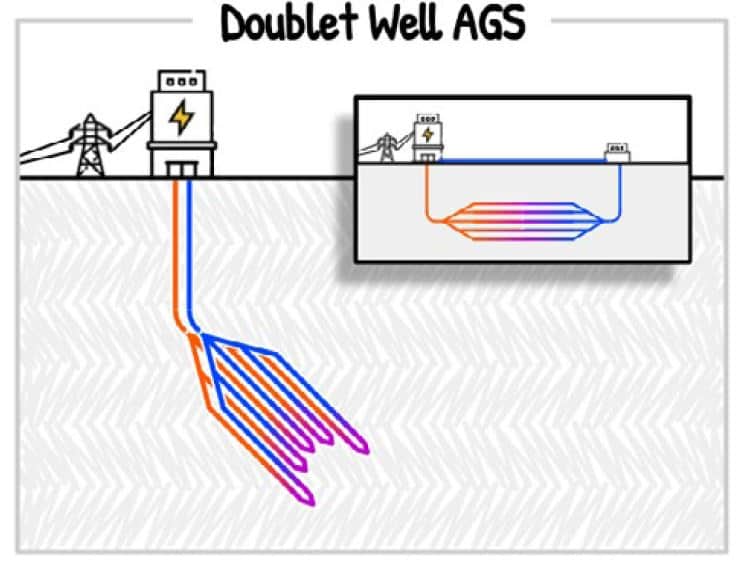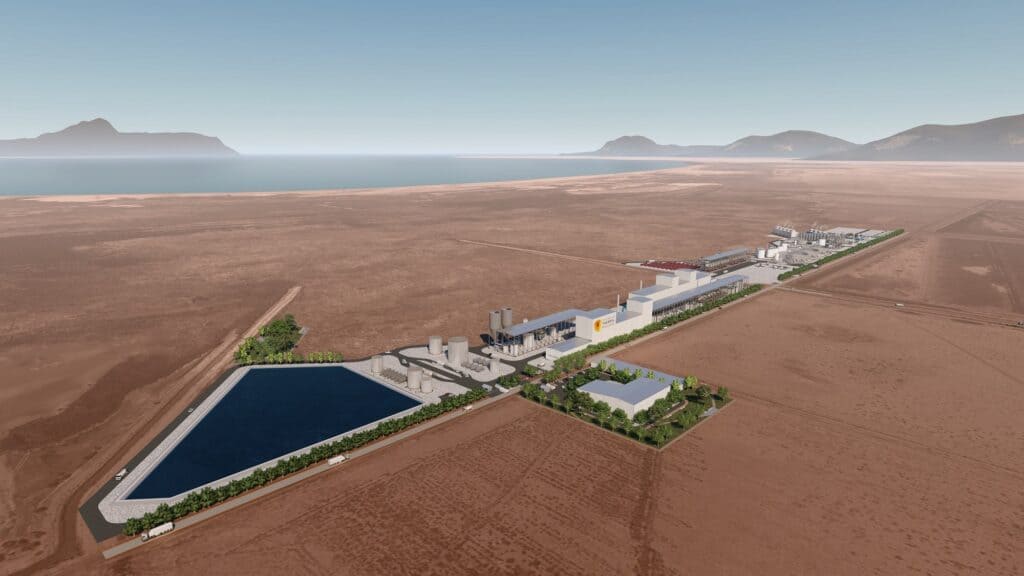Potential environmental impacts related to geothermal plant operations and maintenance include water, air, solids (heavy metals and/or other contaminants), land use, traffic, and noise. Let’s take a look at these concerns over the next few topic pages.
Water & Fluid Management
Produced fluid management during geothermal plant operations depends primarily on the type of plant under consideration. Here we will consider Conventional Hydrothermal Systems and Engineered Geothermal Systems (EGS), which are both Open to Reservoir systems, and Advanced Geothermal Systems/Closed Loop Geothermal Systems (AGS), which are Closed to Reservoir systems.
Open to Reservoir Systems
Open to Reservoir Systems are those in which the working fluid comes in direct contact with the subsurface reservoir, flowing from an injection well through the rock to a production well.1Beard, J.C., and Jones, B.A., eds. (2023, May 1). Chapter 10: Environmental Considerations and Impact. The Future of Geothermal in Texas. p. 269-273. https://energy.utexas.edu/research/geothermal-texas

Although reports of soil and surface water contamination are uncommon near geothermal facilities, some studies have shown that poor water and materials management can lead to both.2Balaban, T. Ö., Bülbül, A., & Tarcan, G. (2017). Review of water and soil contamination in and around Salihli geothermal field (Manisa, Turkey). Arabian Journal of Geosciences, 10(23), 1-20. Others have described pathways to groundwater contamination from operating systems. In one case researchers3Aksoy, N., Şimşek, C., & Gunduz, O. (2009). Groundwater contamination mechanism in a geothermal field: a case study of Balcova, Turkey. Journal of contaminant hydrology, 103(1-2), 13-28. reported that hot geothermal fluids traveled through geologic faults and open spaces in poorly constructed boreholes and contaminated potable surficial aquifers with heat, arsenic, antimony, and boron, rendering the water unusable for drinking or irrigation. Cases like this highlight the importance of proper well construction and active management of geochemical reactions between fluids and well construction materials. Construction of monitoring wells to detect potential groundwater contamination near these types of geothermal systems is also prudent.4Beard, J.C., and Jones, B.A., eds. (2023, May 1). Chapter 10: Environmental Considerations and Impact. The Future of Geothermal in Texas. p. 269-273. https://energy.utexas.edu/research/geothermal-texas
Engineered Geothermal Systems interact with the subsurface far below the water tables and aquifers used for drinking water. Conventional Hydrothermal Systems have rigorous water resource management protocols so the risk of water contamination and spring water depletion are unfounded or nonexistent.5Beard, J.C., and Jones, B.A., eds. (2023, May 1). Chapter 10: Environmental Considerations and Impact. The Future of Geothermal in Texas. p. 269-273. https://energy.utexas.edu/research/geothermal-texas
Closed to Reservoir Systems
Imagine that you had an injection and a production well, similar to EGS, but instead of relying on a network of fractures in the subsurface to connect the two wells, you simply connected them with a pipe. The working fluid would flow down the injection well, horizontally through a lateral segment of pipe, and then up through the production well. Because such a system is closed to the subsurface, it is called a closed-loop system.6Dourado, E. (2021, July 6). The state of next-generation geothermal energy. https://www.elidourado.com/p/geothermal
Fluids are introduced into the subsurface through vertical injection boreholes, flow through well pipes of assorted designs, and exit through production wells. Advanced Geothermal Systems (AGS) such as these are most commonly used in shallow Direct Use Geothermal Systems. System designs are codified by state environmental regulatory agencies. Working fluids are nontoxic, or they contain low-toxicity additives to enhance volumetric heat capacity of the fluid (hence, efficiency of the system).7Beard, J.C., and Jones, B.A., eds. (2023, May 1). Chapter 10: Environmental Considerations and Impact. The Future of Geothermal in Texas. p. 269-273. https://energy.utexas.edu/research/geothermal-texas

Whereas concepts like these have a number of advantages, the system nevertheless relies on effective connection of drill pipes while in the borehole, requiring long term operations without deterioration of connecting points that might be sources of leakage of working fluid into the reservoir. Advances in completion and casing technologies and methodologies may be required to assure that systems such as these operate in a truly closed loop manner, without leakage into the surrounding reservoir. Monitoring studies would provide confidence in the operational integrity of this emerging technology.8Beard, J.C., and Jones, B.A., eds. (2023, May 1). Chapter 10: Environmental Considerations and Impact. The Future of Geothermal in Texas. p. 269-273. https://energy.utexas.edu/research/geothermal-texas
Potential for Using Produced Water
Water that is co-produced with oil and gas is a potential source of working fluids for geothermal, depending on fluid chemistry, need, and access to alternative sources. Two ongoing challenges when using produced water for geothermal (or any other beneficial use) are (1) the variability of produced water quality, especially at concentrations that could lead to problems such as corrosion, and (2) the availability of sufficient quantities of water where and when it is needed.9Beard, J.C., and Jones, B.A., eds. (2023, May 1). Chapter 10: Environmental Considerations and Impact. The Future of Geothermal in Texas. p. 269-273. https://energy.utexas.edu/research/geothermal-texas
Scanlon and others (2020a10Scanlon, B. R., Reedy, R. C., Xu, P., Engle, M., Nicot, J. P., Yoxtheimer, D., … & Ikonnikova, S. (2020). Can we beneficially reuse produced water from oil and gas extraction in the US?. Science of The Total Environment, 717, 137085., 2020b11Scanlon, B. R., Reedy, R. C., Xu, P., Engle, M., Nicot, J. P., Yoxtheimer, D., … & Ikonnikova, S. (2020). Datasets associated with investigating the potential for beneficial reuse of produced water from oil and gas extraction outside of the energy sector. Data in Brief, 30, 105406.) assessed and compared the quantity and quality of produced water across various regions for oil and gas activities, considering different beneficial uses and requirements for quality (for example, when irrigating crops for human consumption). They found median concentrations varying from 1,000 to 200,000 milligrams per liter total dissolved solids (TDS) in the various regions of activity. Depending on fluid chemistry needed for the geothermal technology in question, water with this level of TDS may or may not be suitable without primary or secondary treatment to remove salts, stabilize pH, etc. If treatment is needed, the volume of produced water available could drop by 50 percent, and the concentrate would still require handling and disposal. The decision about using produced water for a geothermal system thus needs to be based on availability of other suitable sources of water, and the economics of treating the water onsite, versus purchasing higher quality water elsewhere, as well as other operational factors.12Beard, J.C., and Jones, B.A., eds. (2023, May 1). Chapter 10: Environmental Considerations and Impact. The Future of Geothermal in Texas. p. 269-273. https://energy.utexas.edu/research/geothermal-texas
Which of these is not a consequence of treating produced water before using it as a working fluid?
Incorrect
Incorrect
Correct
Solid-waste Generation & Fluid Management
Two methods of fluid management can be used to address dissolved constituents in returned working fluid in geothermal systems. One is a flash crystallizer that permanently removes dissolved constituents for subsequent disposal, and the other is pH modification that keeps constituents in dissolved phases for reinjection Depending on the concentration, mineral recovery in the returned geofluids could be economically favorable.13DiPippo, R. (2012). Geothermal power plants: principles, applications, case studies and environmental impact. Butterworth-Heinemann.14Beard, J.C., and Jones, B.A., eds. (2023, May 1). Chapter 10: Environmental Considerations and Impact. The Future of Geothermal in Texas. p. 269-273. https://energy.utexas.edu/research/geothermal-texas
For example, the country’s recent pivot toward renewable electricity generation using wind and solar, as well as the need for substantial electricity storage in batteries, has added urgency to finding sustainable sources of rare earth elements (REE) and critical materials for manufacturing and technology development. Geothermal brines could recover minerals such as lithium, manganese, zinc, potassium and boron.15Beard, J.C., and Jones, B.A., eds. (2023, May 1). Chapter 10: Environmental Considerations and Impact. The Future of Geothermal in Texas. p. 269-273. https://energy.utexas.edu/research/geothermal-texas
The extraction of lithium from geothermal brine is still in a nascent phase. Most efforts use some kind of chemical separation method, to target the separation of lithium chloride, purifying it to produce lithium hydroxide, which is then used for batteries. Many oil and gas companies, geothermal companies, and mining companies are evaluating lithium production from their assets, either as a by-product or as a main product.17Beard, J.C., and Jones, B.A., eds. (2023, May 1). Chapter 3: Other Geothermal Concepts with Unique Applications in Texas. The Future of Geothermal in Texas. p. 67. https://energy.utexas.edu/research/geothermal-texas
The extraction of lithium from geothermal brine is still in a nascent phase. Most efforts use some kind of chemical separation method, to target the separation of lithium chloride, purifying it to produce lithium hydroxide, which is then used for batteries. Many oil and gas companies, geothermal companies, and mining companies are evaluating lithium production from their assets, either as a by-product or as a main product. The methods used for lithium production from geothermal brines are likely to have a smaller environmental footprint compared to other methods.18Beard, J.C., and Jones, B.A., eds. (2023, May 1). Chapter 3: Other Geothermal Concepts with Unique Applications in Texas. The Future of Geothermal in Texas. p. 66-67. https://energy.utexas.edu/research/geothermal-texas

What critical minerals are not of interest to mine from geothermal brines (fluids)?
Correct
Incorrect
Incorrect
Incorrect
Incorrect
Surface Emissions & Monitoring
With regard to any Open to Reservoir geothermal design, potential atmospheric emissions, especially from flash or dry steam plants, including waste heat through steam, and non-condensable gasses (NCG) such as H2S, CO2 and methane have been noted19Bayer, P., Rybach, L., Blum, P., & Brauchler, R. (2013). Review on life cycle environmental effects of geothermal power generation. Renewable and Sustainable Energy Reviews, 26, 446-463.. The waste heat, for example, could be an issue for surrounding biota or residents, and release of NCGs could, of course, offset the value of replacing fossil fuel generating plants with geothermal.20Beard, J.C., and Jones, B.A., eds. (2023, May 1). Chapter 10: Environmental Considerations and Impact. The Future of Geothermal in Texas. p. 269-273. https://energy.utexas.edu/research/geothermal-texas
In states where the development of Closed to Reservoir geothermal systems dominates, as opposed to Conventional Hydrothermal Systems, the concerns outlined above may be substantially mitigated, or even eliminated. Closed to Reservoir systems, such as AGS, separate formation fluids and working fluids. These systems are designed to just produce heat, without producing unwanted contaminants and gasses from the subsurface. Emissions during operations should therefore be kept to a minimum, or eliminated altogether.21Beard, J.C., and Jones, B.A., eds. (2023, May 1). Chapter 10: Environmental Considerations and Impact. The Future of Geothermal in Texas. p. 269-273. https://energy.utexas.edu/research/geothermal-texas
Image Credits
- Traditional-EGS-hydraulic-fracturing-FOGIT: The Future of Geothermal in Texas
- AGS-Doublet-well-FOGIT: The Future of Geothermal in Texas